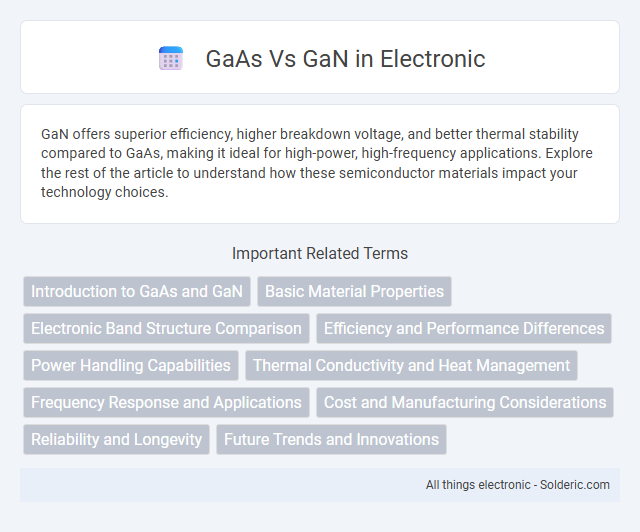GaN offers superior efficiency, higher breakdown voltage, and better thermal stability compared to GaAs, making it ideal for high-power, high-frequency applications. Explore the rest of the article to understand how these semiconductor materials impact your technology choices.
Comparison Table
| Feature | Gallium Arsenide (GaAs) | Gallium Nitride (GaN) |
|---|---|---|
| Bandgap Energy | 1.43 eV (direct bandgap) | 3.4 eV (wide bandgap) |
| Electron Mobility | ~8500 cm2/V*s | ~2000 cm2/V*s |
| Thermal Conductivity | 46 W/m*K | 130-230 W/m*K (higher thermal conductivity) |
| Breakdown Voltage | Lower, ~4 MV/cm | Higher, ~3.3 MV/cm (higher tolerance) |
| Applications | High-frequency RF devices, solar cells, LEDs | Power electronics, RF amplifiers, LEDs, HEMTs |
| Advantages | High electron mobility, mature technology | High power density, high breakdown voltage, efficient heat dissipation |
| Limitations | Lower breakdown voltage, thermal management challenges | Lower electron mobility, higher manufacturing cost |
Introduction to GaAs and GaN
Gallium Arsenide (GaAs) and Gallium Nitride (GaN) are two semiconductor materials known for their distinct electronic properties. GaAs excels in high-speed and high-frequency applications due to its superior electron mobility, making it ideal for RF and microwave devices. GaN offers higher breakdown voltage and thermal stability, enabling your power electronics and high-power RF components to operate efficiently under extreme conditions.
Basic Material Properties
Gallium Arsenide (GaAs) and Gallium Nitride (GaN) differ significantly in their basic material properties, impacting their electronic performance. GaAs has a direct bandgap of approximately 1.42 eV, making it efficient for optoelectronic applications, while GaN features a wider bandgap of about 3.4 eV, enabling high-power and high-frequency devices with better thermal stability. Your choice between GaAs and GaN will depend on the specific requirements related to electron mobility, breakdown voltage, and heat dissipation for your application.
Electronic Band Structure Comparison
Gallium Arsenide (GaAs) features a direct bandgap of approximately 1.42 eV, enabling efficient electron-hole recombination ideal for optoelectronic devices. Gallium Nitride (GaN) possesses a wider direct bandgap of about 3.4 eV, providing high breakdown voltage and superior thermal stability for high-power and high-frequency applications. The increased bandgap in GaN results in lower intrinsic carrier concentration and improved performance in harsh environments compared to GaAs.
Efficiency and Performance Differences
GaN devices exhibit higher efficiency and superior performance compared to GaAs, especially in high-power and high-frequency applications due to GaN's wider bandgap and higher electron mobility. GaN's ability to operate at higher voltages and temperatures results in reduced energy loss and improved thermal management, enhancing overall system efficiency. Your choice between GaAs and GaN should consider these efficiency and performance differences to optimize device functionality in demanding environments.
Power Handling Capabilities
Gallium Nitride (GaN) outperforms Gallium Arsenide (GaAs) in power handling capabilities due to its higher breakdown voltage and superior thermal conductivity. GaN devices support higher power densities and operate efficiently at elevated temperatures, making them ideal for high-power applications such as RF amplifiers and power electronics. Your choice of GaN technology can significantly enhance performance in systems requiring robust power management and efficiency.
Thermal Conductivity and Heat Management
GaN exhibits superior thermal conductivity compared to GaAs, enabling more efficient heat dissipation in high-power applications and reducing the risk of device overheating. Effective heat management in GaN-based devices enhances reliability and performance under extreme conditions, making it ideal for power amplifiers and RF components. Your choice of GaN over GaAs can significantly improve thermal efficiency and long-term device stability in demanding environments.
Frequency Response and Applications
GaN (Gallium Nitride) demonstrates superior frequency response compared to GaAs (Gallium Arsenide) due to its higher electron mobility and wider bandgap, enabling operation at higher frequencies and power densities. GaN is extensively used in high-frequency applications such as RF amplifiers, 5G technology, and radar systems, where efficient power handling and thermal stability are critical. GaAs remains prevalent in microwave and millimeter-wave applications like satellite communications and low-noise amplifiers, benefiting from its mature manufacturing processes and inherent material properties.
Cost and Manufacturing Considerations
GaAs (Gallium Arsenide) devices generally have lower manufacturing costs compared to GaN (Gallium Nitride) due to mature production techniques and availability of substrates, making them more cost-effective for mass-market applications. GaN fabrication requires more expensive substrates like silicon carbide, along with complex epitaxial growth processes, driving up overall costs despite superior performance in high-power and high-frequency scenarios. When balancing cost and manufacturing efficiency, your choice depends on application scale and budget constraints, with GaAs favored for cost-sensitive projects and GaN for cutting-edge, high-efficiency needs.
Reliability and Longevity
Gallium Nitride (GaN) offers superior reliability and longevity compared to Gallium Arsenide (GaAs) due to its higher thermal conductivity and robust material properties, which enable it to operate efficiently under higher temperatures and power densities. GaN devices demonstrate enhanced resistance to degradation from electrical stress and thermal cycling, resulting in extended operational lifespans in high-frequency and high-power applications. Conversely, GaAs tends to exhibit faster wear-out mechanisms under similar conditions, limiting its long-term durability especially in demanding environments.
Future Trends and Innovations
Gallium Arsenide (GaAs) and Gallium Nitride (GaN) are evolving with GaN showing significant promise in high-power and high-frequency applications due to its superior electron mobility and thermal conductivity. Innovations in GaN technology focus on developing more efficient power amplifiers and RF devices for 5G and beyond, whereas GaAs continues to dominate in photonics and optoelectronics with emerging advances in integrated circuits. Your investment in GaN-based systems could leverage future breakthroughs in efficiency and miniaturization, positioning you at the forefront of semiconductor innovation.
GaAs vs GaN Infographic

 solderic.com
solderic.com